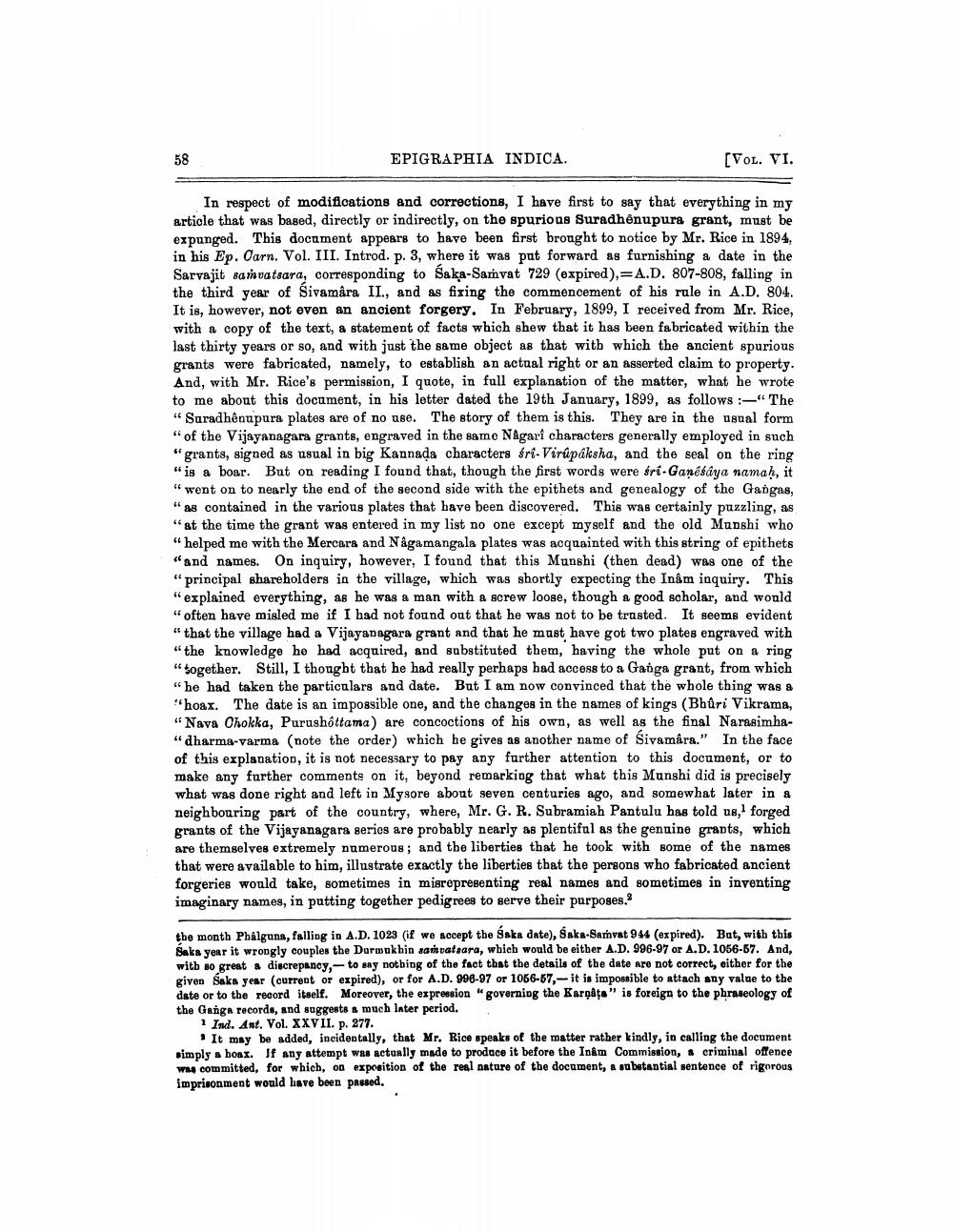________________
EPIGRAPHIA INDICA.
[VOL. VI.
In respect of modifications and corrections, I have first to say that everything in my article that was based, directly or indirectly, on the spurious Suradhênupura grant, must be expunged. This document appears to have been first brought to notice by Mr. Rice in 1894, in his Ep. Oarn. Vol. III. Introd. p. 3, where it was put forward as furnishing a date in the Sarvajit samvatsara, corresponding to Saka-Samvat 729 (expired),=A.D. 807-808, falling in the third year of Sivamâra II., and as fixing the commencement of his rule in A.D. 804. It is, however, not even an ancient forgery. In February, 1899, I received from Mr. Rice, with a copy of the text, a statement of facts which shew that it has been fabricated within the last thirty years or so, and with just the same object as that with which the ancient spurious grants were fabricated, namely, to establish an actual right or an asserted claim to property. And, with Mr. Rice's permission, I quote, in full explanation of the matter, what he wrote to me about this document, in his letter dated the 19th January, 1899, as follows :-" The "Saradhênupura plates are of no use. The story of them is this. They are in the usual form "of the Vijayanagara grants, engraved in the same Nagari characters generally employed in such "grants, signed as usual in big Kannada characters fri-Virúpáksha, and the seal on the ring " is a boar. But on reading I found that, though the first words were fri-Ganesaya namah, it "went on to nearly the end of the second side with the epithets and genealogy of the Gangas, "as contained in the various plates that have been discovered. This was certainly puzzling, as "at the time the grant was entered in my list no one except myself and the old Munshi who "helped me with the Mercara and Nagamangala plates was acquainted with this string of epithets
and names. On inquiry, however, I found that this Munshi (then dead) was one of the "principal shareholders in the village, which was shortly expecting the Inam inquiry. This "explained everything, as he was a man with a screw looge, though a good scholar, and wonld “often have misled me if I had not found out that he was not to be trusted. It seems evident " that the village had a Vijayanagara grant and that he must have got two plates engraved with "the knowledge he had acquired, and substituted them, having the whole put on a ring "together. Still, I thought that he had really perhaps had access to a Ganga grant, from which "he had taken the particulars and date. But I am now convinced that the whole thing was a
hoax. The date is an impossible one, and the changes in the names of kings (Bhůri Vikrama, "Nava Chokka, Purushottama) are concoctions of his own, as well as the final Narasimha"dharma-varma (note the order) which he gives as another name of Sivamära." In the face of this explanation, it is not necessary to pay any further attention to this document, or to make any further comments on it, beyond remarking that what this Munshi did is precisely what was done right and left in Mysore about seven centuries ago, and somewhat later in a neighbouring part of the country, where, Mr. G. R. Subramiah Pantulu has told us, forged grants of the Vijayanagara series are probably nearly as plentiful as the genuine grants, which are themselves extremely numerous; and the liberties that he took with some of the names that were available to him, illustrate exactly the liberties that the persons who fabricated ancient forgeries would take, sometimes in misrepresenting real names and sometimes in inventing imaginary names, in putting together pedigrees to serve their purposes.
the month Pbalguna, falling in A.D. 1028 (if we accept the Saka date), Saka-Sarvat 944 (expired). But, with this Saka year it wrongly couples the Durmukhin samvatsara, which would be either A.D. 996-97 or A.D. 1056-57. And, with so great # discrepancy,- to say nothing of the fact that the details of the date are not correct, either for the given Saks year (current or expired), or for A.D. 996-97 or 1066-57,- it is impossible to attach any value to the date or to the record itself. Moreover, the expression " governing the Karpa" is foreign to the phraseology of the Gange records, and suggests a much Inter period.
1 Ind. Ant. Vol. XXVII. p. 277.
* It may be added, incidentally, that Mr. Rice speaks of the matter rather kindly, in calling the document simply a hoax. If any attempt was actually made to produce it before the In&m Commission, & criminal offence was committed, for which, on exposition of the real nature of the document, a substantial sentence of rigorous imprisonment would have been passed.




